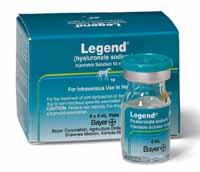Joint Injections: Effective Procedure but Risk of Complications from Misuse
 |
|
Joint Injection |
Using a small needle to inject into the joint and surrounding tissues is a common procedure in hospitals for treating certain conditions such as: osteoarthritis, tendinitis, bursitis, and non-infectious arthritis in chronic joint diseases (like rheumatoid arthritis, ankylosing spondylitis, etc.).
Medications Used in Joint Injections
Common medications injected into joints include corticosteroids and sodium hyaluronate (Hyasyn).
Corticosteroids: Typically used in suspension form, with brands such as prednisolone, methylprednisolone, and triamcinolone.
Clinical studies on corticosteroid injections into the knee joint show that a single dose of 20mg triamcinolone (equivalent to 25mg prednisolone) provides pain relief lasting from 1 to 4 weeks. A dose of 40mg triamcinolone extends pain relief for 16-24 weeks (Raynauld J, 2003). The 40mg dose is also the recommended dosage by the American College of Rheumatology. Typically, this dosage is repeated every 3 months for up to 2 years. In cases of joint effusion causing inflammation of the synovial membrane, corticosteroids can act as anti-inflammatories, making it beneficial to perform a selective aspiration alongside the injection to enhance the drug’s efficacy.
Injecting corticosteroids into tendons to treat synovial membrane injuries, peritendinous tissues, and tendon insertion sites, while applied, lacks a solid theoretical basis and compelling clinical evidence proving its efficacy, often resulting in complications. Except for the improvement observed in the index finger for tendon degeneration and inflammation (Lambert, 1992), most experiments involving tendon injections for shoulder impingement (rotator cuff tendinopathy), lateral epicondylitis (tennis elbow), and Achilles tendinopathy have not yielded better results than control groups.
Sodium Hyaluronate (Hyasyn)
Hyaluronate is a natural substance in the human body, found in high concentrations in joint tissues and synovial fluid, serving as a lubricant, shock absorber, and protector of the joints. The reduction of hyaluronate in synovial fluid and loss of cartilage are key factors in osteoarthritis. The drug’s effects include:
 |
| Legend Injection (sodium hyaluronate) – Image: bullwrinklerx |
Reducing pain (by decreasing the production of PEG, reducing bradykinin production, inhibiting pain perception), anti-inflammatory effects (by preventing PGE production and blocking cytokine effects), inhibiting cartilage degradation, and promoting cartilage cell synthesis.
Clinical research indicates that for patients over 40 with knee pain and osteophytes, reduced synovial fluid, or stiffness after 5 weeks of treatment with a combination of non-steroidal anti-inflammatory drugs and paracetamol along with sodium hyaluronate (at a dose of 25mg weekly for 5 weeks), 93% of patients experience pain relief. In contrast, only 10% of patients achieve similar results with non-steroidal anti-inflammatory drugs and paracetamol alone (Thái Thị Hồng Anh, 2005).
While local swelling and redness may occur, the injection of corticosteroids and sodium hyaluronate into the joint does not typically result in significant side effects. Previously, there were concerns that corticosteroid injections could accelerate joint destruction and muscle atrophy, but many studies now suggest that such progression is not due to corticosteroid injections but rather the inherent nature of the disease.
In the absence of a definitive cure (except for costly joint replacement), joint injections of corticosteroids and sodium hyaluronate meet patient expectations: improving symptoms safely and at a low cost.
Complications from Misuse of Joint Injection Procedures
Performing joint injections at home or in primary healthcare settings lacking adequate conditions often leads to errors.
Regarding Indications: Rheumatologists typically recommend joint injections only when non-steroidal anti-inflammatory drugs are ineffective (in cases of severe disease) and should not be used in cases of septic arthritis or infections at the injection site. Due to patients’ preference for injections (inspired by quick results seen in others) and the insufficient qualifications of home healthcare providers, injections are often unnecessarily recommended for all cases of arthritis, including mild cases and even septic arthritis.
Some individuals may also use various medications such as vitamin B12, antibiotics, or non-steroidal anti-inflammatory drugs, or mix them with corticosteroid suspension for joint injection. The use of such medications is inappropriate, and mixing drugs or combining them with corticosteroid suspension can destroy the formulation. This can lead to severe consequences: strong inflammatory reactions in the synovial membrane, damage to synovial tissues, cartilage, causing swollen and painful joints, leading to joint adhesion and loss of joint function.
Regarding Injection Technique: Due to a lack of anatomical knowledge and proficiency, incorrect injection sites may result in poor drug delivery and efficacy. More dangerously, if injections are misplaced into muscles, bones, blood vessels, or nerves surrounding the joint, it can lead to severe complications such as muscle atrophy, osteoporosis, and loss of joint function. Additionally, repeated injections in one area or superficial injections can cause skin atrophy and loss of pigmentation at the site. Rarely, patients may experience dizziness, sweating, chest tightness, or difficulty breathing if they panic, if the injection is too rapid, or if it inadvertently enters a blood vessel.
Regarding Equipment and Facilities: At home or in some primary healthcare facilities, there is often no designated injection room or adequate sterilization equipment, leading to severe complications such as joint destruction, adhesions, and serious infections that can cause disability or death if not detected and treated early with specific high-dose antibiotics.
To perform a joint injection, it is essential to have a qualified rheumatologist who can accurately identify anatomical landmarks and possesses adequate skills to inject correctly; a sterile environment and equipment are also crucial. Patients should not readily accept this procedure at home or in primary healthcare settings that do not meet these conditions, as it can easily lead to dangerous complications.
Dr. BUI VAN UY


















































